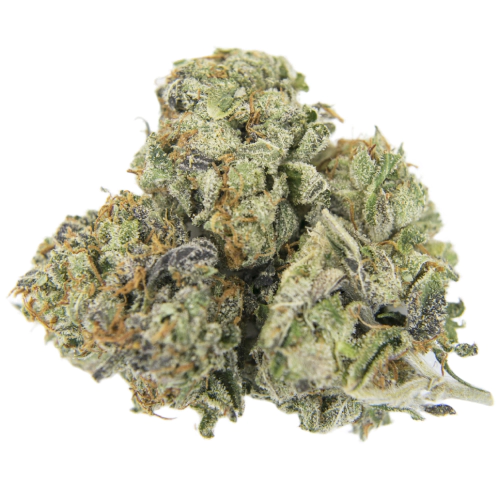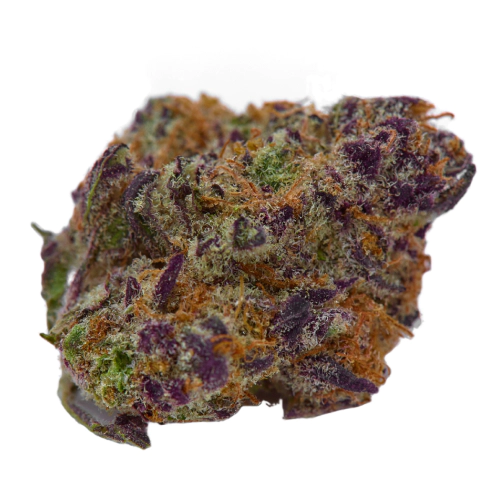THC 18.33 - 20.33%
CBD 0.63 - 0.88%
Effect Euphoric
Flavor Spicyherbal
20 - 22%
0.52 - 0.8%
0.71 - 0.71%
Lime, Ammonia
Happy
If you cannot figure out which marijuana strains you like more, Sativa or Indica, you should try hybrid strains. Gusher Pie is one of the best options for experienced consumers. It has an extremely rich flavor profile due to the fact that it’s a cross of Gushers with Rainbow Pie F2 strains. Tastes and effects are also determined by the chemical makeup. Veteran smokers will enjoy its potency because of high amounts of THC cannabinoids - 20-22%. Here are the volumes of other chemical components:
Tastes always depend on terpenes. Because of the extensive terpene profile, the Gusher Pie weed strain evolves various smells and flavors. To be more specific, here is the content of all the terpenes presented in this weed:
If you are fond of sweet marijuana, you will hardly enjoy dabbing this weed. Although myrcene, pinene, and limonene terpenes are included, their impact is very weak, so the sweet hints of lime, lemon, apple, pine, apricot, and berries will be very insignificant. The combination of humulene and geraniol terpenes provides rather chemical flavors. You will taste diesel and ammonia aromas, accompanied by soft hints of coffee and tobacco. To cut a long story short, the flavor profile is very rich, and maybe, some gustatory sensations of the cannabis strain will appeal to you.
Gusher pie is a potent strain, first inhales of which make smokers happy and giggly. You can even get euphoric, but immediately after these feelings, complete relaxation comes. The strain makes users creative, so it’s a perfect choice to have fun at the party.
However, you must be careful when smoking or dabbing such strong weed because high amounts of THC cannabinoids may easily do the dirty on you. Although there are not many side effects reported, we are sure that the severe feeling of dry eyes isn’t the stuff you expect from the high-quality weeds.
The rich profile of chemical components makes Gusher Pie strain helpful for treating:
Experienced marijuana growers say that Gusher Pie is one of the easiest strains to grow. If you provide a proper water regime, you will easily harvest the yield of 10 - 15 Oz in approximately 63 days after putting the plant in soil. If you prefer growing weed indoors, Gusher Pie will meet your requirements as well – indoor, you can expect the 1 - 2 Oz yield.
| THC | Tetrahydrocannabinol, or THC, is a major cannabis chemical compound. It is a psychoactive element that stimulates dopamine release and induces euphoria or happiness. THC-rich strains may be helpful with such conditions as lack of appetite, chronic pains , etc. It is considered to be the primary active marijuana component. | 20 - 22% |
| CBD | Cannabidiol, or CBD, is a major compound in cannabis, which is non-psychoactive. It is also proved to counteract the side effects of the second major component THC. CBD is widely used for medicinal purposes in rubs, oils and so on. It is helpful in muscle pain cases, may treat arthritis and migraines. Even Greeks used it against pain, while Queen Victoria applied it to get rid of menstrual cramps. | 0.52 - 0.8% |
| CBC | Cannabichromene, or CBC, is a minor cannabinoid, meaning that its quantity in cannabis is quite little. Though it has the same origin as CBD and THC, it is different in functions. Without any psychoactive effects, it is an efficient cannabis compound in combating acne and depression. CBC produces analgesic, antibacterial and anti-inflammatory effects. | 0.31 - 0.39% |
| CBG | Cannabigerol, or CBG, is one of the minor cannabis compounds in adult plants. On the other hand, young ones contain a lot of this antibacterial and anti-inflammatory component. During the growth, CBG is converted into different cannabinoids, mostly THC and CBD. The compound itself increases appetite and decreases eye pressure. | 0.71 - 0.71% |
| CBN | Cannabinol, or CBN, is a trace element in cannabis that is considered to be mildly psychoactive. It appears from oxidation THC, exposed to light and heat. CBN is mostly contained in old cannabis and in traditional hashish. It is effective against insomnia, bacterial infections and appetite loss. | 0.05 - 0.19% |
| THCV | Tetrahydrocannabivarin, or THC-V, is a compound contained in cannabis in trace amounts. Even though it is close to THC molecularly, it is different in effects. This compound may be psychoactive only in large amounts. THC-V reduces blood sugar, controls appetite, stimulates bone growth, etc. African Sativa strains are the richest in THC-V. | 0.01 - 0.19% |
| Carene | Carene (also known as Delta-3 carene) is a terpene found in rosemary, lemons, pines, and cedars, offering citrusy and cypress aroma. Studies on mice showed that carene provides anti-inflammatory effects, as well as promotes bone health and chronic pain relief. | 0.01% |
| Pinene | Pinene is one of the most widespread terpenes in nature, found in pine trees, basil, nutmeg, parsley, and rosemary. Cannabis containing terpene (alpha-pinene or α-pinene) boasts a strong pine scent. Pinene is responsible for anti-inflammatory, pain-relieving, and anti-anxiety effects. | 0.06% |
| Myrcene | Myrcene (also known as β-myrcene) is one of the most common terpenes found in cannabis, representing more than 20% of the modern marijuana terpene profile. Myrcene has a distinct earthy, musky flavor, resembling cloves. It is responsible for calming and soothing effects of weed. Myrcene is also found in hops, thyme, mango, lemongrass, guava melon. | 0.2% |
| Geraniol | Geraniol is a terpene initially contained in geraniums, as well as lemongrass, lemon peels, roses, blueberries, and carrots. The aroma is a sweet rose scent with notes of citrus. Geraniol features anti-inflammatory, antibacterial, antifungal, and neuroprotectant properties. It's rumored to have side effects such as allergic contact dermatitis or sensitive skin irritation. | 0.13% |
| Humulene | Humulene (also known as α-humulene) is one of the major terpenes found in cannabis, contributing to woody, earthy, spicy, herbaceous, and, mainly, floral aromas of cannabis. Used in modern medicine, humulene offers anti-inflammatory, antibacterial, and appetite suppressant effects, which have been well-researched by pharmaceutical companies. | 0.12% |
| Limonene | Limonene (also known as d-limonene) is the second most common terpene in nature and the third most common terpene in cannabis. It has a powerful citrus aroma and can be found in all citruses, including lemons, oranges, grapefruits, limes, juniper, etc. Limonene is known to elevate moods and provide anxiety, depression, and stress relief. | 0.1% |
| Linalool | Linalool (also known as beta linalool, linalyl alcohol, linaloyl oxide, and p-linalool) is one of the rarest terpenes found in cannabis, mostly in small quantities. Linalool is known for its spicy and lavender aroma, bringing relaxation and calming effects. It is also said to provide anti-inflammatory and analgesic properties that can be useful for athletes. | 0.17% |
| Sabinene | Sabinene is a terpene with a peppery, spicy, citrusy, and piney aroma, presented in Norway spruce, Holm oak trees, black pepper, cardamom, and carrot seeds. Found in cannabis in small quantities. Allegedly, sabinene has anti-inflammatory and antimicrobial properties. | 0.03% |
| Bisabolol | Bisabolol (also known as α-Bisabolol or levomenol) is a lesser-known terpene found in cannabis. It contributes to anti-inflammatory, anti-irritant, antioxidant, anti-microbial, and analgesic properties of weed strains containing bisanol. Attentive smokers would be able to catch a nutty, fruity scent with herbal and floral undertones, with a tender trace of coconut. | 0.04% |
| Nerolidol | Nerolidol (also known as trans-nerolidol) is a terpene found in jasmine, tea tree, and lemongrass, as well as in some cannabis strains. Nerolidol has a distinguished floral aroma with notes of citrus, apples, and rose. The terpene has sedative, anti-anxiety, antimicrobial, anti-parasitic, anti-oxidant, and pain-relieving properties. | 0.04% |
| Terpineol | Terpineol (also known as alpha-terpineol or a-terpineol) is a terpene naturally occurring in more than 150 plants, including lilacs, lime blossoms, eucalyptus sap, and pines. Among the therapeutic qualities are anti-inflammatory, antioxidant, antitumor, and antimicrobial. In cannabis, terpineol boasts the distinctive pine smoke aroma and causes a relaxing, sedative effect. | 0.1% |
| Total terpenes content | 1.00% |
THC 18.33 - 20.33%
CBD 0.63 - 0.88%
Effect Euphoric
Flavor Spicyherbal
THC 17.75 - 20.25%
CBD 0.48 - 0.65%
Effect Creative
Flavor Sweet
THC 20 - 23.5%
CBD 0.28 - 0.62%
Effect Happy
Flavor Berry

THC 18.33 - 20.33%
CBD 0.32 - 0.64%
Effect Happy
Flavor Lemon
THC 15 - 23%
CBD 3 - 3.23%
Effect Euphoric
Flavor Spicyherbal
THC 19.5 - 21%
CBD 0.47 - 0.86%
Effect Relaxed
Flavor Earthy

THC 18.5 - 19.5%
CBD 0.41 - 1.12%
Effect Relaxed
Flavor Earthy
THC 17 - 17%
CBD 0.55 - 0.84%
Effect Relaxed
Flavor Mango
Be the first and share your opinion
Write a Review